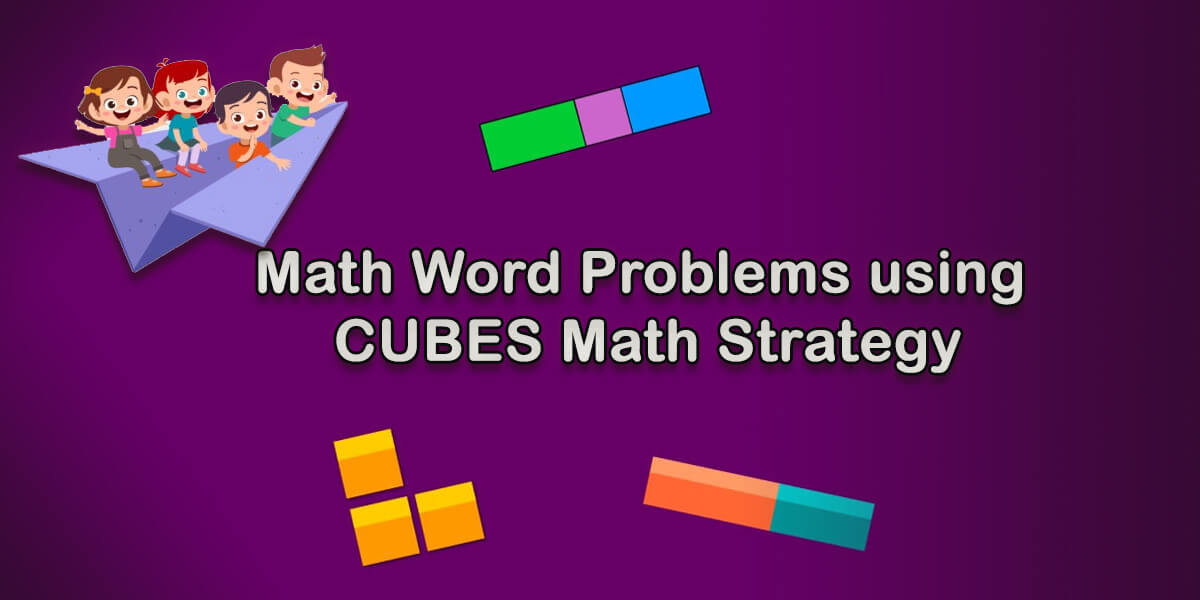Students usually have to deal with math word problems during their early stages of education. There are different strategies that are used to solve these problems and CUBES math strategy is one of the most effective ones.
It is a proper strategy where you follow 5 different steps in order to tackle the world problem you are solving. This makes it easier for students to identify the main components of the problem and their relation with each other.
This identification helps them understand how they can solve the Math Word problem they are solving. In today’s article, we will discuss this strategy in detail and help you know how you can employ it to solve word problems.
What is CUBES?
CUBES is a handy mnemonic device that stands for the six essential steps to solve word problems systematically:
- Circle important numbers and keywords
- Underline the question being asked
- Break the problem into smaller, more manageable parts or phrases
- Evaluate each individual part by solving using order of operations, properties of operations, or relevant formulas and showing your work step-by-step
- Solve the original question by combining the solutions from each part
- Explain your thought process and reasoning clearly.
By following this structured yet flexible process methodically, even complex multi-step story problems become less intimidating as you break them down into clear, organized solutions. Let’s explore each CUBES step in more detail.
Step 1: Circle Key Details
The first crucial step is to carefully read the entire word problem slowly at least twice while highlighting all important numerical values, variables, units of measurement, and keywords that provide context clues with your colored pencil, marker or highlighter. This may involve quantifying adjectives such as “more” or “less” and circling phrasing around words like “total” or “difference.” Take your time to ensure no critical information is overlooked. You may even consider re-reading the problem aloud and have a peer confirm the most pertinent details are clearly circled or boxed.
Step 2: Underline the Question
Once you’ve highlighted all notable facts, numbers and terms, it’s time to refocus your efforts on the specific question or unknown value being asked for by underlining it with a straight blue or black line. Underlining isolates the end goal you need to solve for from any extraneous details, helping center your approach. If the question asks to calculate an unknown amount, clearly underline the variable as well to keep track of what needs to be solved for.
Step 3: Break into Parts

Now break the problem down into smaller, more bite-sized pieces by writing each part out step-by-step on your paper using statements, phrases, diagrams, or mathematical equations or expressions. You may find it helpful to categorize the information thematically, chronologically, or by operation type. The key is to logically organize the facts so each part can be worked on independently before combining solutions. Numbering or lettering each section also helps reference steps easily.
Step 4: Evaluate the Parts
With the problem broken into clear, organized parts, you’re now ready to start solving piece-by-piece. Work through each individual part methodically, showing all mathematical work and thought processes step-by-step using proper order of operations, properties of numbers, relevant formulas, diagrams, charts or other visual aids when applicable. Be sure to label equations and simplify expressions where possible to arrive at solutions for each part.
Step 5: Solve and Check
Now that you’ve solved all constituent parts, it’s time to combine the answers logically to find the solution to the original question or unknown amount underlined in Step 2. Reread your work to catch any computational errors before confirming your final solution makes logical sense given the context of the original problem. Consider verifying solutions with a classmate or online calculator when possible.
Step 6: Explain Your Reasoning
The final step is just as important as it demonstrates full understanding beyond just arriving at an answer. Clearly communicate the thought process, logic, and steps taken to solve the problem by explaining the purpose and application of each part of the CUBES Math Strategy. Explanations showcase higher-order thinking and cement new concepts.
Read More: Learning Guide for Jordan Math Work System
Additional Practice
Let’s apply CUBES Math Strategy to additional word problems involving multiple steps, variables, fractions, decimals, percentages and measurement conversions. Work through examples independently then check your understanding. Explore challenging multi-concept questions and don’t hesitate to ask for clarification or assistance on any part of the process.
Real-World Applications

Word problems allow us to practice mathematical skills in authentic scenarios like calculating total costs, comparing rates of change, planning projects, analyzing statistical data and more. Generate your own real-world story problems for peers to solve applying the CUBES Math Strategy.
Additional Resources
Beyond this overview, continue cultivating problem-solving skills through online tutorials, workbooks and challenge problems. Consider sharing strategies virtually with study groups. Reach out for one-on-one support as needed. With focused practice over time, algebraic reasoning and logical thinking skills will continue developing. You’ve got this!
Additional Exercises
Now that we’ve covered the CUBES Math Strategy framework and some introductory examples, let’s reinforce these concepts through interactive practice. Work through the next five word problems independently, showing all steps clearly according to the strategy. Then, exchange papers with a classmate to peer review one another’s work – did you both arrive at the right solution and fully explain your reasoning?
Feel free to ask one another clarifying questions as needed. Finally, check your work against the answer keys I’ve provided. Don’t hesitate to rework any problems you may have gotten incorrect until you fully understand the process. Practicing application is key to mastery.
Common Mistakes
With any new skill, common missteps may occur when first learning CUBES Math Strategy – and that’s perfectly okay! Identifying and addressing errors proactively helps improvement. Common mistakes include: skipping steps, not showing work, overlooking key details, making careless computational errors, failing to check answers, and explaining thoughts vaguely.
To minimize these, slow your pace and be meticulous in each step. Have patience with yourself, and don’t be afraid to ask for assistance on any part of the process. With focused effort and experience over time, you’ll strengthen problem-solving muscle memory and begin to see connections between multiple concepts. Keep at it – you’ve got this!
Conclusion:
CUBES math strategy is one of the most effective strategies used to solve math word problems. It is a combination of 5 different steps that help you understand the main component of the problem. After that, you can apply relevant math formulas to solve the word problem.




